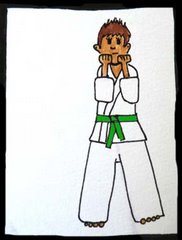March 3rd was traditionally Girl’s Day, a national holiday when families pray for the health and happiness of their daughters. Nowadays it is no longer a holiday but the Hina Doll Festival is still celebrated. Families display sets of dolls that have often been handed down through generations, and make offerings of fresh mochi (rice cakes) coloured green, white and pink and cut into diamond shapes. The red/pink is for chasing evil spirits away, the white is for purity, and the green is for health. The sets of dolls are displayed on a five or seven tiered stand covered in red carpet, like a small set of stairs leading up to where the Emporer and Empress perch on the top step. The next step contains three court ladies, followed by five musicians, two ministers, and three servants ending the bottom row in a five-tiered display. Some of the older dolls I saw were over 100 years old.
 Hina Matsuri, like many things Japanese, was a cleansing custom originally imported from China: a girl’s imperfections are passed into a paper doll which was subsequently floated down the river. In some regions the custom is still practiced. My friend Omae San invited me to view the Hina Doll Festival in the neighbouring town of Utazu. The weekend after the 3rd, families and businesses within the old part of the town had opened up their homes for the general public to view their displays. To be honest, I was much more interested in seeing the inside of Japanese homes than in viewing the doll sets; many newer versions I had seen for sale in stores, and considered a tad gaudy for my taste. We went to the Utazu Town Office to drink some ceremonial sake and collect a map of the walking route. Some 80 or 90 residences were partaking in the festival. It was a beautiful late winter’s Sunday, crisp and blue, pleasant in the sun, a tad nippy in the shade. Our first stop was a very large, old house that has been restored as a museum of some sort. Guides were on hand to explain the history of the dolls and the house, and between their exuberance, Omae San’s patchy English and my delinquent Japanese I think I became more confused than enlightened. I spent a lot of time nodding my head enthusiastically and spouting Ahh sooo desu ne, guessing at meanings that an occasional ray of understanding would splinter into beautiful rainbow textured shards.
Hina Matsuri, like many things Japanese, was a cleansing custom originally imported from China: a girl’s imperfections are passed into a paper doll which was subsequently floated down the river. In some regions the custom is still practiced. My friend Omae San invited me to view the Hina Doll Festival in the neighbouring town of Utazu. The weekend after the 3rd, families and businesses within the old part of the town had opened up their homes for the general public to view their displays. To be honest, I was much more interested in seeing the inside of Japanese homes than in viewing the doll sets; many newer versions I had seen for sale in stores, and considered a tad gaudy for my taste. We went to the Utazu Town Office to drink some ceremonial sake and collect a map of the walking route. Some 80 or 90 residences were partaking in the festival. It was a beautiful late winter’s Sunday, crisp and blue, pleasant in the sun, a tad nippy in the shade. Our first stop was a very large, old house that has been restored as a museum of some sort. Guides were on hand to explain the history of the dolls and the house, and between their exuberance, Omae San’s patchy English and my delinquent Japanese I think I became more confused than enlightened. I spent a lot of time nodding my head enthusiastically and spouting Ahh sooo desu ne, guessing at meanings that an occasional ray of understanding would splinter into beautiful rainbow textured shards. 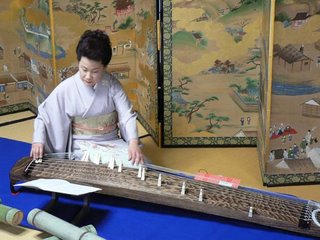 In the first main room, a women dressed in a kimono, knelt in front of a Koto, a thirteen stringed zither like instrument, which she was delicately playing. It lent a perfect atmosphere to this perfectly preserved old house built around a central garden, the rocks, moss and stone pools the zen image of how a Japanese garden should look. The corridors that edged the house double as an insulation barrier; large windows letting in light, the rooms themselves separated by sliding paper screens that can be opened or removed to allow ventilation and more or less light as desired.
In the first main room, a women dressed in a kimono, knelt in front of a Koto, a thirteen stringed zither like instrument, which she was delicately playing. It lent a perfect atmosphere to this perfectly preserved old house built around a central garden, the rocks, moss and stone pools the zen image of how a Japanese garden should look. The corridors that edged the house double as an insulation barrier; large windows letting in light, the rooms themselves separated by sliding paper screens that can be opened or removed to allow ventilation and more or less light as desired.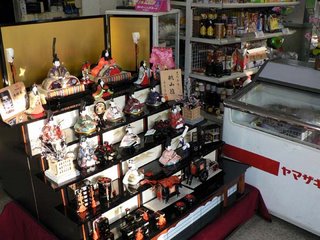
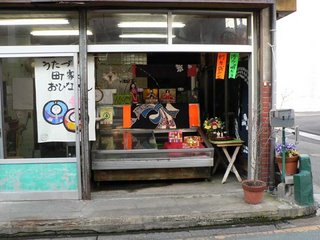 We finally head back outside and followed the meandering groups of people drifting here and there. Some houses had a small display viewable through a window, others had devoted whole rooms to the hospitality of their collections. A few stores had joined in the celebrations; I particularly enjoyed the contrast created by this small grocery store that had forsaken product space for doll space, and a fish shop that had managed to squeeze in a display.One of the last houses we visited was home to a women who had spent some time studying in Australia, some years back. On display they had a picture painted by an old man of the district, which she insisted on giving to me. It being Sunday afternoon, the Matsuri was drawing to a close and she had been looking for a suitable home for this piece. In a gesture of international solidarity, I a chance stranger she had just met, was to be the recipient of this gift. She also made the gift through Omae San, so I wasn’t really sure if she was giving it to me or not until we walked outside and Omae San presented it to me. Another instance of the generosity of spirit of the Japanese people that has made me feel so welcome since I have been here.
We finally head back outside and followed the meandering groups of people drifting here and there. Some houses had a small display viewable through a window, others had devoted whole rooms to the hospitality of their collections. A few stores had joined in the celebrations; I particularly enjoyed the contrast created by this small grocery store that had forsaken product space for doll space, and a fish shop that had managed to squeeze in a display.One of the last houses we visited was home to a women who had spent some time studying in Australia, some years back. On display they had a picture painted by an old man of the district, which she insisted on giving to me. It being Sunday afternoon, the Matsuri was drawing to a close and she had been looking for a suitable home for this piece. In a gesture of international solidarity, I a chance stranger she had just met, was to be the recipient of this gift. She also made the gift through Omae San, so I wasn’t really sure if she was giving it to me or not until we walked outside and Omae San presented it to me. Another instance of the generosity of spirit of the Japanese people that has made me feel so welcome since I have been here.
Thank you.
As I walk back to my apartment after work, a little old lady is walking in front of me, hunched over from too many years in the rice paddies perhaps. She carries an extra long pair of BBQ tongs and a paper bag. As I walk behind watching, she stops and hunches even further over to pick up a stray cigarette butt someone has discarded into the gutter and deposits it into her paper bag.
An early morning, a later than expected start, a long day. But omoshiroii.It was my first time across the Seto Ohashi Bridge, that which I have gazed at, run towards and made partway across upon a wayward train. Actually I think it was my Kanji reading ability that was wayward. This mammoth engineering feat, part of a massive road expansion scheme last century, comprises 12km of adjoining bridges which cross from Shikoku to Honshu. As I may have previously mentioned, Shikoku was the backwater until 1988, when many of those reading this would have been caught up in a hype of an altogether different kind. Most in Japan still regard those from my home island as country bumpkins, and after the coolness Hiroshimians displayed today, I would be inclined to agree. But who wants to live in a big city anyway?However, as big cities go, it struck me (in a very fast day) as a pretty liveable place. It’s surrounded by mountains, and the longest tunnels I’ve yet encountered in Japan, some over 2km. However, being guided around by your Japanese friend in a very comfortable car with nabe, jostling from carpark to carpark, possibly isn’t the best way to get a good impression of a place. The pleb in me would much rather have been getting lost on the tram system. Despite nabe, we still managed to get lost though. Nabe is a navigation system that tells you where you are and how to get where you want. All the important places of interest are included, from the Peace Park to the major department stores. Pretty much all new cars have one and Japanese aren’t big on old cars. A calm woman’s voice interrupts your conversations to politely tell you where and when to turn, when you’ve arrived somewhere, etc. It also doubles as a TV in case the batteries on your keitai (cell phone) are flat and you need an electronic device to distract you whilst you’re driving. I guess a tv would keep the kids quiet forever when you subsequently run into a concrete tunnel wall. So speaking of death and destruction, our first stop in Hiroshima was the Memorial Peace Park. If I sound a tad cynical it’s probably because my emotional defences are pretty high after seeing too many photographs and relics of scorched and mangled bodies. My friends scored themselves a volunteer guide and though I was quite happy picking up about 20% percent of what she was saying (my Japanese is slowly getting better) and reading the helpful English explanations lining the walls, they decided this was too important an occasion and the gist would not suffice, so I got my own personal guide and we were subsequently parted.Hiroshima has historically been a military centre of power. The Sino-Japanese war and the following Manchurian invasion were launched from here. When the Pacific War broke out in 1941, Hiroshima served again as an important military base. And when the Americans were looking for a place to drop a devastating weapon, Hiroshima served a number of important criteria. It was more than three and a half kilometres wide and surrounded by mountains, this making it an excellent guinea pig city on which to test their new toy. Most importantly, intelligence indicated that Hiroshima was the only military stronghold that contained no POW camps. I guess dropping the world’s first atomic bomb on your own people is bad for PR.Keiko San, my guide, spent a lot of time telling me how nasty the Japanese soldiers had historically been in conflict. It made me feel uncomfortable hearing this peaceable women denigrate her fellow countrymen so. She went on and on about the atrocities the Japanese had committed and I wondered if she hadn’t been to some modern day Clockwork correction camp. The Koreans who are outraged by Koyazumi’s visits to the war shrine to pay respect, because a small number of known war criminals are included in the list of soldiers, should listen to this women if they want proof of how contrite the Japanese are. But that’s a different debate that I don’t understand completely.The Japanese, like most people, are fiercely proud of their culture and identity. I asked Keiko San how it felt, day after day, telling the world (for their were tourists from all over) what bad people the Japanese were. For her, the essence was in the tense; the Japanese were, but now are not.After the Japanese surrendered, a couple of days after Nagasaki was likewise flattened, a contingent of peacekeeping soldiers was sent into Japan to restore order. Keiko San described how the Hiroshimians were scared of the soldiers that were to be sent over because they expected them to loot, pillage and rape, as is the wont of soldiers. Instead, she said, the people were surprised by a bunch of friendly Australians, and here she went into raptures over how wonderful the Aussies were. I felt ill and embarrassed.It was weird. The Japanese, though they had changed, would forever have to bear the shame of past atrocities; whilst the Australians, for once being of good behaviour, would always be heroes to these people. I tried to explain about recent conflict in the Middle East, how Australians are as base as anyone, but that didn’t matter. My brain was unsuccessfully searching for a sixth gear as I tried to mesh these juxtaposing attitudes. For the first time in Japan I felt truly culturally alienated from the Japanese. Most things I don’t understand in Japan I put down – perhaps ignorantly – to ignorance. But this wasn’t a question of lack of information or communicational ability. We just thought differently. Not as I might have a different opinion to someone with a similar educational and cultural background, but on a different planet. And I spent the rest of the week trying to get my head around this.Keiko San was a peace activist and an anti-nuclear activist. Her grandmother had been one the of survivors of the bomb, but like many, was too traumatised to talk about it. Keiko San, like many of the next generation, had taken it upon herself to educate about the dangers of nuclear capabilities. I told her about Jabiluka, of which she hadn’t heard, and instead of convincing her of the evilness of the Australian Government, it confirmed me as a fellow activist and she found that sixth gear I was still looking for. Unfortunately I wasn’t in the mood to be preached at and soon got tired of her well intentioned but slightly jarring hypes for peace. I believe there’s more chance of the Bush family giving over their entire fortune to provide AIDS relief in Africa than there is of us ever finding world peace through love and enlightenment.Having said that, don’t get me wrong, I think what Keiko and her colleagues are doing is bloody excellent. These people give up vast tracts of their time to educate the rest of the world about the effects of the Atomic Bomb on Hiroshima. Just because I don’t agree with all her views, doesn’t mean I consider them less relevant. It takes a whole planet of people to change our world and there can never be one true formula.We continued to pass by remains of clothing, photos of burnt and charred bodies, and a museum full of emotionally plaguing material. However, I didn’t need to see this stuff and was more interested in learning about the radiation effects After spending several years hearing how the half life of radiation dug up from Jabiluka would last 20,000 years - more of less by a few thousand years - I have always been curious how it possible for a city to be rebuilt on a site where a bomb was exploded, whilst the area around Chernobyl will never be habitable whilst our species is still writing history. Unfortunately Keiko was unable to give me an answer so had to turn to the internet:The initial radiation from the explosion lasted for a minute and the strongest effects were felt within a radius of one km from the hypocentre. The residual radiation lasted for 100 hours; anyone who came within this zone during this period also suffered from radiation exposure. However, irradiation of soil and buildings is caused from the absorption of radioactive neutrons. “Neutrons comprise 10% or less of A-bomb radiation . . . in contrast, gamma rays--which comprise the majority of A-bomb radiation--do not cause ground materials to become radioactive.” *Thus most of the radioactivity decayed quickly and the levels of residual radiation in Hiroshima are less than normal background levels.The last part of the tour was dedicated to a little girl called Sadako. She was a baby when the bomb struck, though suffered no noticeable effects. At age 12 she suddenly developed leukaemia, then known as A-Bomb disease. As you would be, she was super scared as all those who had contracted the disease had died. Her friend told her of a legend whereby if a sick person folds 1000 paper cranes, they will get better. She died having folded only 644 cranes.Her friends started folding cranes to honour her memory and word soon spread. Money streamed in from all over the world and 3 years later a monument was built in Sadako’s memorial. Every year children from all around the world send cranes to be placed at the memorial annually on August 6th, Hiroshima Day.
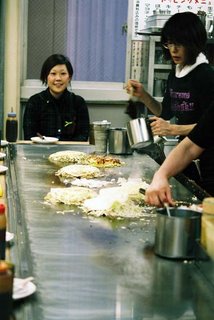 We had ostensibly come to Hiroshima to do some shopping for Yuka Chan’s work, (this is her grinning expectantly on the left) things she couldn’t get on Shikoku. When I asked why we hadn’t gone to Okayama or Osaka, two big cities much closer, she made various asides about traffic and the difficulty of driving, and then grinned and said “Okonomiyaki.” Each region has it’s own speciality dish that cannot be made authentically outside of that region. To eat Sanuki Udon outside of Sanuki, the old name for the region I live in, is considered a heresy. People come from all over Japan to eat Udon noodles in Kagawa, and similarly, we had come to Hiroshima to eat Okonomiyaki.Rather like a
We had ostensibly come to Hiroshima to do some shopping for Yuka Chan’s work, (this is her grinning expectantly on the left) things she couldn’t get on Shikoku. When I asked why we hadn’t gone to Okayama or Osaka, two big cities much closer, she made various asides about traffic and the difficulty of driving, and then grinned and said “Okonomiyaki.” Each region has it’s own speciality dish that cannot be made authentically outside of that region. To eat Sanuki Udon outside of Sanuki, the old name for the region I live in, is considered a heresy. People come from all over Japan to eat Udon noodles in Kagawa, and similarly, we had come to Hiroshima to eat Okonomiyaki.Rather like a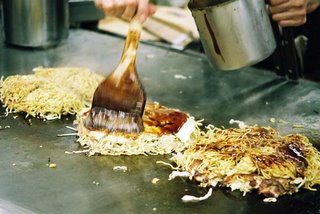 pancake style sandwich, it’s made on a hotplate that doubles as the bench at which you sit. The smiling women seemed quite used to having their photos taken and I went a bit nuts with my camera as they prepared this elaborate dish in front of us, the hotplate between us and them. The pancake batter serves as the top and bottom, in between lies a veritable feast of cabbage, vegetables and most importantly, according to Hiroshima style, fried noodles of the ramen variety. It’s usual to include large quantities of beef, bacon and seafood in between, but this of course was out for me. The whole thing was topped of with slatherings of Special Okonomiyaki Sauce, mayonnaise, seaweed and spring onions. When ready it was cut into four quarters and slid across the hotplate, where you eat it then and there. Can’t get much fresher really.
pancake style sandwich, it’s made on a hotplate that doubles as the bench at which you sit. The smiling women seemed quite used to having their photos taken and I went a bit nuts with my camera as they prepared this elaborate dish in front of us, the hotplate between us and them. The pancake batter serves as the top and bottom, in between lies a veritable feast of cabbage, vegetables and most importantly, according to Hiroshima style, fried noodles of the ramen variety. It’s usual to include large quantities of beef, bacon and seafood in between, but this of course was out for me. The whole thing was topped of with slatherings of Special Okonomiyaki Sauce, mayonnaise, seaweed and spring onions. When ready it was cut into four quarters and slid across the hotplate, where you eat it then and there. Can’t get much fresher really.
Yum!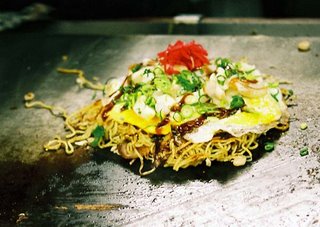 * If you’re more interested in radiation effects, I found this information at a little site put together by Hiroshima International School. Thank you.
* If you’re more interested in radiation effects, I found this information at a little site put together by Hiroshima International School. Thank you.
 Hina Matsuri, like many things Japanese, was a cleansing custom originally imported from China: a girl’s imperfections are passed into a paper doll which was subsequently floated down the river. In some regions the custom is still practiced. My friend Omae San invited me to view the Hina Doll Festival in the neighbouring town of Utazu. The weekend after the 3rd, families and businesses within the old part of the town had opened up their homes for the general public to view their displays. To be honest, I was much more interested in seeing the inside of Japanese homes than in viewing the doll sets; many newer versions I had seen for sale in stores, and considered a tad gaudy for my taste. We went to the Utazu Town Office to drink some ceremonial sake and collect a map of the walking route. Some 80 or 90 residences were partaking in the festival. It was a beautiful late winter’s Sunday, crisp and blue, pleasant in the sun, a tad nippy in the shade. Our first stop was a very large, old house that has been restored as a museum of some sort. Guides were on hand to explain the history of the dolls and the house, and between their exuberance, Omae San’s patchy English and my delinquent Japanese I think I became more confused than enlightened. I spent a lot of time nodding my head enthusiastically and spouting Ahh sooo desu ne, guessing at meanings that an occasional ray of understanding would splinter into beautiful rainbow textured shards.
Hina Matsuri, like many things Japanese, was a cleansing custom originally imported from China: a girl’s imperfections are passed into a paper doll which was subsequently floated down the river. In some regions the custom is still practiced. My friend Omae San invited me to view the Hina Doll Festival in the neighbouring town of Utazu. The weekend after the 3rd, families and businesses within the old part of the town had opened up their homes for the general public to view their displays. To be honest, I was much more interested in seeing the inside of Japanese homes than in viewing the doll sets; many newer versions I had seen for sale in stores, and considered a tad gaudy for my taste. We went to the Utazu Town Office to drink some ceremonial sake and collect a map of the walking route. Some 80 or 90 residences were partaking in the festival. It was a beautiful late winter’s Sunday, crisp and blue, pleasant in the sun, a tad nippy in the shade. Our first stop was a very large, old house that has been restored as a museum of some sort. Guides were on hand to explain the history of the dolls and the house, and between their exuberance, Omae San’s patchy English and my delinquent Japanese I think I became more confused than enlightened. I spent a lot of time nodding my head enthusiastically and spouting Ahh sooo desu ne, guessing at meanings that an occasional ray of understanding would splinter into beautiful rainbow textured shards. 

 We finally head back outside and followed the meandering groups of people drifting here and there. Some houses had a small display viewable through a window, others had devoted whole rooms to the hospitality of their collections. A few stores had joined in the celebrations; I particularly enjoyed the contrast created by this small grocery store that had forsaken product space for doll space, and a fish shop that had managed to squeeze in a display.
We finally head back outside and followed the meandering groups of people drifting here and there. Some houses had a small display viewable through a window, others had devoted whole rooms to the hospitality of their collections. A few stores had joined in the celebrations; I particularly enjoyed the contrast created by this small grocery store that had forsaken product space for doll space, and a fish shop that had managed to squeeze in a display.


